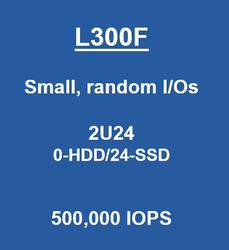
June 19, 2018
By: Michael Feldman
Supercomputer-maker Cray has announced the ClusterStor L300F, a Lustre-based SSD storage system that joins a growing list of all-flash solutions.
 In a nutshell, the L300F is designed to operate as a high-performance scratch storage pool for Lustre environments. As such, its intended use is for handling small random I/O operations, in particular, those associated with the generation of intermediate results. By avoiding the long latencies inherent in hard disks, application runtimes can be significantly reduced, making it easier for jobs to be completed within their scheduled time allotment.
In a nutshell, the L300F is designed to operate as a high-performance scratch storage pool for Lustre environments. As such, its intended use is for handling small random I/O operations, in particular, those associated with the generation of intermediate results. By avoiding the long latencies inherent in hard disks, application runtimes can be significantly reduced, making it easier for jobs to be completed within their scheduled time allotment.
“Flash is poised to become an essential technology in every HPC storage solution,” said Jeff Janukowicz, IDC’s research vice president, Solid State Drives and Enabling Technologies. “It has the unique role of satisfying the high-performance appetite of artificial intelligence applications even while helping customers optimize their storage budget for big data. With the ClusterStor L300F, Cray has positioned itself to be at the leading edge of next generation of HPC storage solutions.”
In most cases, the L300F will be paired with one of its two ClusterStor siblings, the all-HDD L300 or the mixed HDD/SDD L300N, the goal being to get the right balance between IOPS and capacity. A L300 system provides up to 82 hard drives, and as a standalone solution, is mainly targeted for environments dealing primarily with large, sequential I/O. It provides just 4,000 IOPS. By contrast the L300N combines up to 80 hard drives with four SSDs and is aimed at mixed sequential/random I/O workloads. Each enclosure can deliver up to 40,000 IOPS. Both the L300 and L300N are based on 5U building blocks.
Being an all-flash design, the L300F is quite different in most respects. It puts 24 SSDs into a 2U enclosure, delivering up to 500,000 IOPS. The L300F uses a dual-port SAS interface to eliminate the threat of a path failure. Like other ClusterStor systems, it comes with both object storage servers and object storage targets. Cray is claiming the 2U system will “scale linearly and with no performance loss.”
That rather limited description leaves out some basic information, such as storage capacity, latency, and bandwidth. Presumably that will be revealed when the L300F become generally available, which Cray is currently scheduling for the end of August.
In the meantime, if you’re curious about the L300F and happen to be attending the ISC High Performance conference later this month in Frankfurt, Germany, you can stop by Cray’s booth (E-921) and get the full story.
